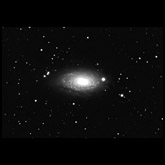Galaxies come in many shapes. The strangest are of course those galaxies that have been smashed and stretched by a close encounter with a neighboring galaxy. Arp 244 is a prime example of such a cosmic collision. The most beautiful are probably those like M51 that sport ordered and symmetric spiral arms. Somewhere in between is M63.
Unlike the obvious pattern of M51, it is almost impossible to trace the arms of M63. Rather than two large arms, M63 seems to have hundreds of little arm segments, each aligned in such a way as to suggest a spiral pattern. Look at the pattern closely: you will not be surprised to hear that M63 is often called the "Sunflower Galaxy."
Why is M63 different from M51? No one knows exactly. Spiral arms are formed by density waves that propagate through the disk of the galaxy as it spins. Such a mechanism is likely to be highly sensitive to initial conditions: the speed of rotation, the amount of gas in the disk, the distribution of dark matter, etc. Perhaps M63 had more gas and a faster rotation than M51. Perhaps it was the other way around. Either way, these differences make M63, M51 and every other spiral galaxy unique—another reason why I find them so fascinating.
Imaging Notes
M63 is a bright galaxy that rewards all capture attempts, no matter the skill level. Beginners will have no problems finding it high in the sky in April, May, and June, while advanced and intermediate imagers can concentrate on maximizing depth and resolution.
Though the core and disk of the galaxy are bright, there is a faint and ragged extended halo around M63. Increase the length of your sub-exposures as much as you can to capture these areas. In particular, make sure that the straight dust lane at the southern edge of the galaxy is visible against the faint glow of the extended halo.
More Images
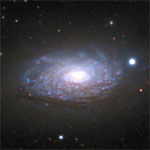 |
Chuck Domaracki |
Meade 10" LX-200ACF — CCD-Labs Q453 — 220 minutes color (20 minute exposures) |
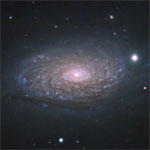 |
Tom Victor Kolkin |
Meade 10" LX-200ACF @f/6.8 — Artemis 4021— LRGB 70:30:30:30 (5 minute subs) |
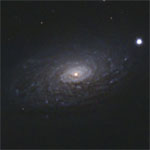 |
Jerry Lodriguss |
Astro-Physics 130EDT — Canon EOS 20Da DSLR — 120 minutes color (7.5 minute exposures) |
 |
Jean-Jacques Rapp |
Takahashi TSA102 — DSI Pro II — 230 minutes luminance (10 minute subs) |
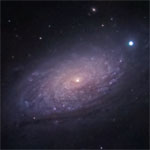 |
Jim Thommes |
Celestron C8 f/6.7 — Artemis285 — LRGB 77:21:21:21 (7- and 3-minute subs) |
All images ©copyright by their respective owners.
Want your image here? Send mail to: [email protected]

